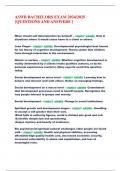ASWB BACHELORS EXAM 2024/2025
{QUESTIONS AND ANSWERS }
When should self determination be limited? - CORRECT ANSWER Only in
situations where it would cause harm to a client or others.
Jean Piaget - CORRECT ANSWER Developmental psychologist best known
for his theory of cognitive development. Theory states that children
learn through interaction in the environment.
Nature vs nurture - CORRECT ANSWER Whether cognitive development is
mainly determined by a clients innate qualities (nature), or by his
personal experiences (nurture). Many experts avoid this question
today.
Social development on micro level - CORRECT ANSWER Learning how to
behave and interact well with others. Relies on managing feelings.
Social development on a macro level - CORRECT ANSWER Commitment
that development processes need to benefit people. Recognizes the
way people interact in groups and society.
Social development - CORRECT ANSWER Change in social institutions.
Spiritual growth and development stages - CORRECT ANSWER -Unwilling
to accept a will greater than their own.
-Blind faith in authority figures, world is divided into good and evil.
-Scientific skepticism and questioning.
-Enjoys mystery and beauty of existence.
Bio psychosocial-spiritual-cultural challenges older people are faced
with - CORRECT ANSWER Health and physical abilities, accessing
affordable-high quality health care, decreased economic security,
increased vulnerability to abuse and exploitation, and loss of
meaningful roles.
,Health care issues with adults 80+ - CORRECT ANSWER Communication:
Encourage to express feelings, stay positive
Health: monitor closely, promote self care, ensure nutrition, stress,
and activity levels
Safety:ensure safe living
Development - CORRECT ANSWER Product of the elaborate interplay of
biological, psychological, spiritual, and social influences
John Bowlby - CORRECT ANSWER Originated Attachment Theory.
Attachment: defined by Bowlby - CORRECT ANSWER A lasting
psychological connectedness that can be understood within an
evolutionary context in which a caregiver provides safety and security
to a child. Child is pre-programmed to create attachments.
Monotropy - CORRECT ANSWER One primary attachment figure. Acts as a
secure base for exploring the world.
Learned behavior attachment - CORRECT ANSWER Child will form an
attachment to whoever feeds it. Child finds comfort in food, through
classical conditioning, finds comfort in feeder. Child uses operant
conditioning to get what it wants.
Stranger anxiety - CORRECT ANSWER Crying when an unfamiliar person
tries to hold child, begins between 5-9 months. Intensifies at age 1,
stops around age 2.
Separation anxiety - CORRECT ANSWER Beings 6-8 months, peaks at 14-18
months, resolved by 24-36 months. Upset when caregiver leaves sight.
Separation anxiety disorder - CORRECT ANSWER Characterized by
excessive worrying about being away from caregiver. Occurs in later
childhood.
,Maslow's hierarchy of needs - CORRECT ANSWER Clients are motivated to
meet certain needs, when one is filled they seek the next one.
(physiological, safety, social, esteem, self-actualization)
Physiological needs - CORRECT ANSWER Maintain the physical organism.
Biological needs such as food/water/oxygen/ temperature.
Safety needs - CORRECT ANSWER Need to feel safe from
harm/danger/threat.
Social needs - CORRECT ANSWER Friendship, intimacy, affection, and love
are needed.
Esteem needs - CORRECT ANSWER Need of a stable, firmly based level of
self respect and respect from others.
Self-actualization - CORRECT ANSWER Ongoing process of need to be
oneself, act consistently with whom one is.
Humanistic approach - CORRECT ANSWER clients have the capacity to
grow, change, and adapt.
Strength - CORRECT ANSWER Any ability that helps and individual to
confront and deal with a stressful life situation and to grow from it.
Strengths perspective - CORRECT ANSWER Focuses on understanding
clients on the basis of their strengths and resources and mobilizing
the resources to improve their situations.
Defense mechanisms - CORRECT ANSWER Behaviors that protect people
from anxiety. Automatic, involuntary, usually unconscious
psychological activities to exclude unacceptable thoughts, urges,
threats, and impulses form awareness for fear of disapproval,
punishment, or other negative outcomes. (NOT coping mechanisms-
voluntary)
Examples of defense mechanisms - CORRECT ANSWER Turning against
self, Splitting, repression... (SEE PAGE 57)
, Erikson - CORRECT ANSWER Psychosocial model (8 stages)
Group work - CORRECT ANSWER Method of social work that helps
individuals enhance their social functioning as well as cope with their
problems. Individuals help each other change/learn social roles, social
worker helps change environment/behavior.
Individual self-actualization occurs when: - CORRECT ANSWER Release of
feelings that block social performance, support from others,
reappraisal of self.
Psychodrama - CORRECT ANSWER Treatment approach in which roles are
enacted in a group context
Stages of group development - CORRECT ANSWER Preaffiliation (forming),
Power and Control (storming), Intimacy (norming), Differentiation
(performing), Termination (adjourning).
Individuals to keep out of group work - CORRECT ANSWER Clients in crisis,
suicidal, compulsive, needs attentjion, psychotic, paranoid.
Groupthink - CORRECT ANSWER Group makes faulty decisions because of
group pressure.
Group polarization - CORRECT ANSWER Discussion strengthens a
dominant point of view and results in a shift to a more extreme
position than any of the members would adopt on their own.
Family systems approach - CORRECT ANSWER In order to understand a
family system, a social worker must look at the family as a whole
rather than on its members.
Family systems theory - CORRECT ANSWER All parts of the family are
interrelated. Must look at the relationships and interactions between
members. Families strive for homeostasis.




